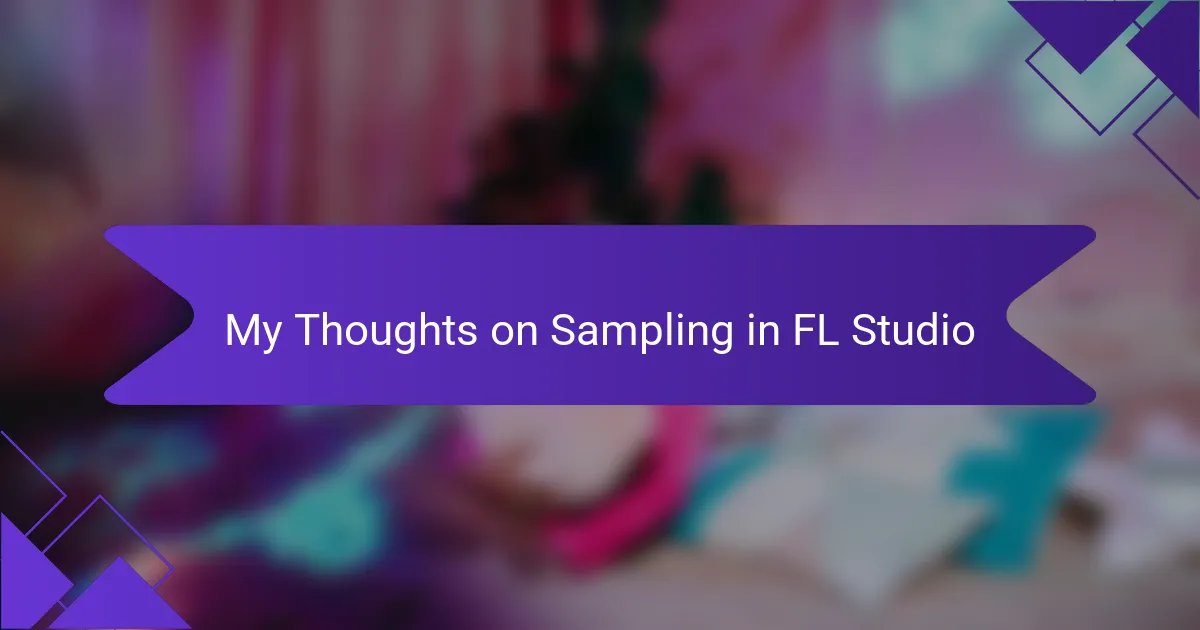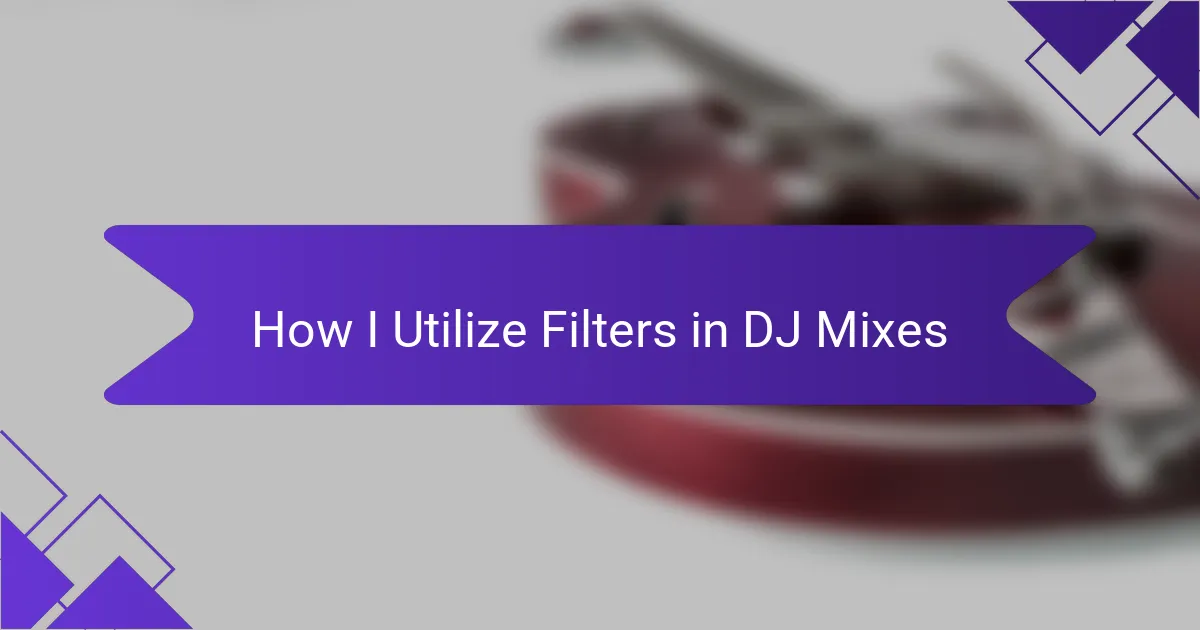Key takeaways
- DJ mixing is about creating an emotional journey for listeners, using techniques like beatmatching and effects to enhance the experience.
- Software, such as Traktor, is essential for flexibility, organization, and creativity in crafting unique mixes.
- Techniques like layering elements, using effects strategically, and adjusting energy levels can elevate mixes and engage audiences effectively.
- Regular practice, customizing controller mappings, and utilizing Remix Decks are key strategies for mastering DJ skills with software like Traktor.
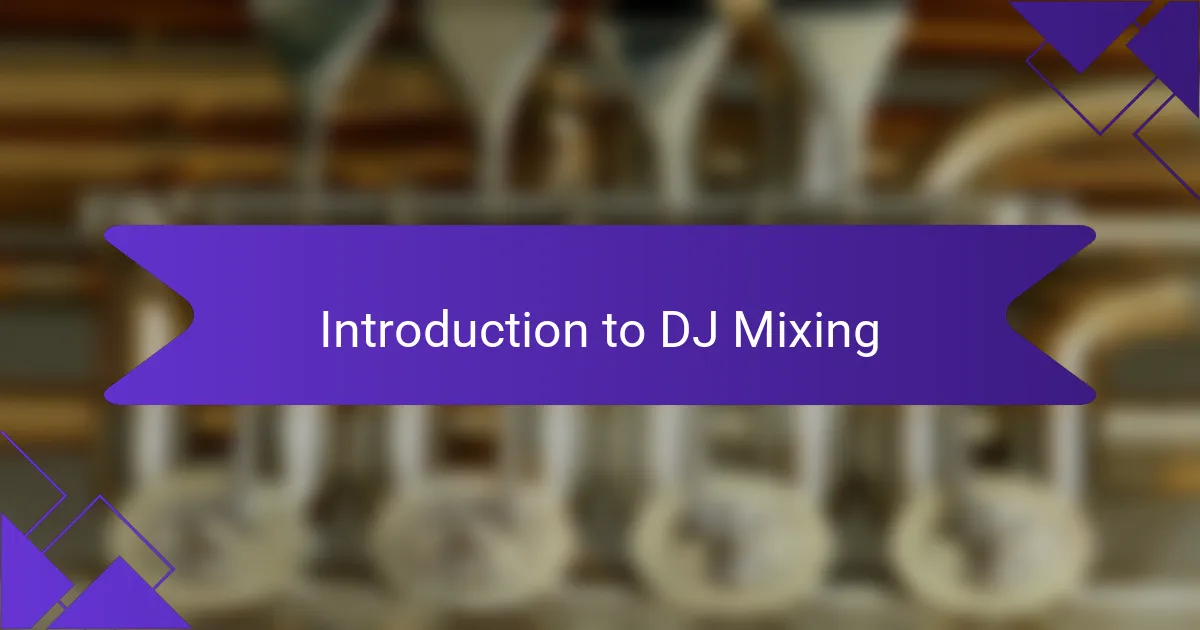
Introduction to DJ Mixing
DJ mixing is an art form that goes beyond just playing tracks back-to-back. In my experience, it’s about creating a journey for the listeners, where each beat, melody, and transition pulls them deeper into the experience. Have you ever felt that goosebumps moment when a DJ flawlessly transitions from one track to another? It’s magical.
Every DJ has their unique style and approach to mixing, and I’ve spent countless hours experimenting with different techniques. From beatmatching to using effects, each method brings out a different flavor in the music. I remember the first time I successfully mixed two songs together; that adrenaline rush was exhilarating and kept me coming back for more.
As I delve into DJ mixing, I often reflect on the emotional connection music fosters. It’s a universal language that resonates with each of us on a personal level. Whether you’re out on the dance floor or behind the decks, the thrill of crafting a perfect mix is simply unmatched. What do you think makes a mix truly exceptional? For me, it’s the stories we tell through music.
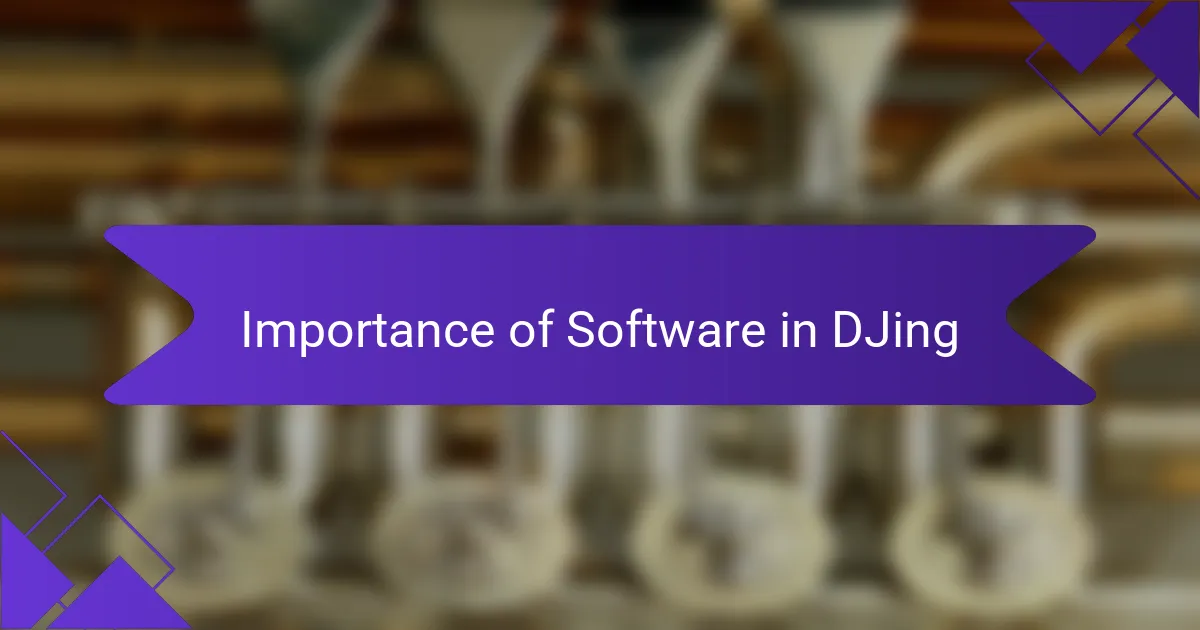
Importance of Software in DJing
When I first started DJing, I quickly realized that having the right software could truly elevate my performances. Experimenting with different platforms taught me that the ease of mixing, the variety of effects, and the organization of tracks can make or break a set. I remember the thrill of seamlessly transitioning between genres in a live show, thanks to the intuitive interface and features of my software.
Understanding the importance of software in DJing means recognizing how it enhances creativity and efficiency. Many DJs, including myself, rely on software not just for mixing but also for crafting a unique sound that reflects our personal style. Here are a few key factors that underline why software is essential in DJing:
- Flexibility: Tailor your sets with various effects and sound manipulation.
- Organization: Easily manage and categorize your music library for quick access.
- Precision: Achieve accurate beat matching and tempo adjustments effortlessly.
- Creativity: Experiment with samples, loops, and live remixing.
- Integration: Connect with hardware and other software for a comprehensive setup.
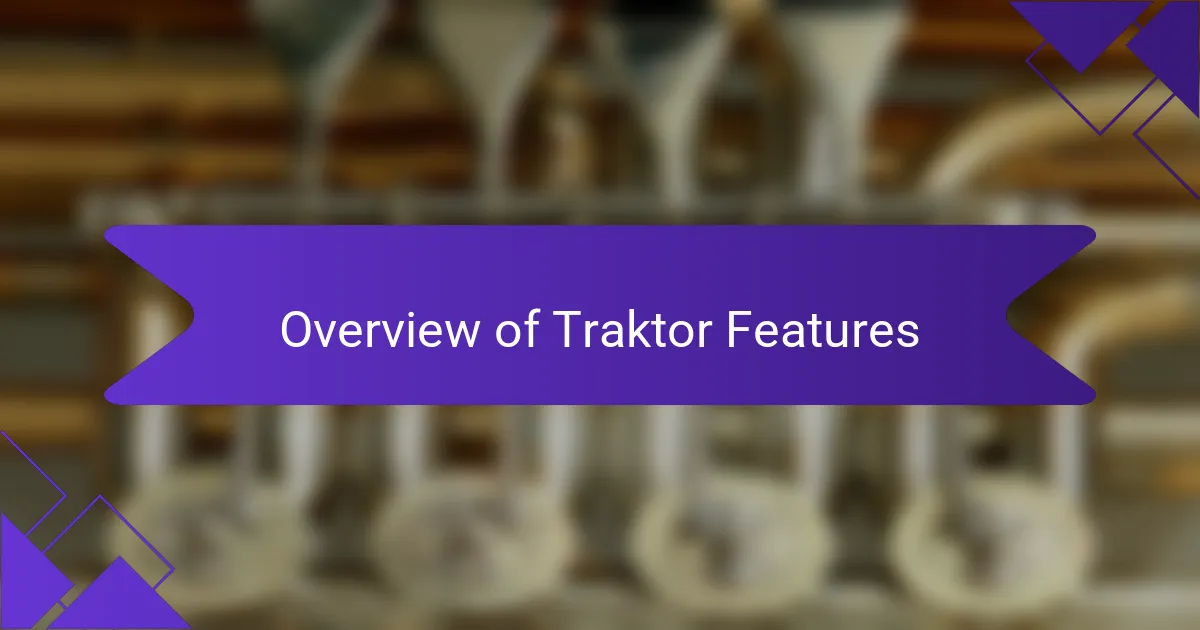
Overview of Traktor Features
When I first started using Traktor, I was amazed by its extensive features that perfectly catered to my mixing style. The software offers a seamless integration of music management and performance tools, allowing me to experiment with various effects and transitions effortlessly. The ability to customize my workflow has truly amplified my creativity.
Here’s a concise overview of some standout features of Traktor:
- Intuitive Interface: User-friendly layout that makes navigation simple, even during live performances.
- Advanced Mixing Tools: Includes looping, cue points, and beat-synced effects that enhance my mixing capabilities.
- Syncing Options: Automatic beatmatching that helps maintain a flawless flow during sets.
- Stems and Remix Decks: Provides unique ways to remix tracks on the fly, which I find exhilarating in live settings.
- Customizable FX Units: Allows me to tailor effects to suit my style, giving my sets a distinct sound.
I still remember the first time I sicked the remix decks—being able to manipulate tracks live felt like unlocking a new level in my DJ journey. These features are not just tools; they’re my creative partners during performances.
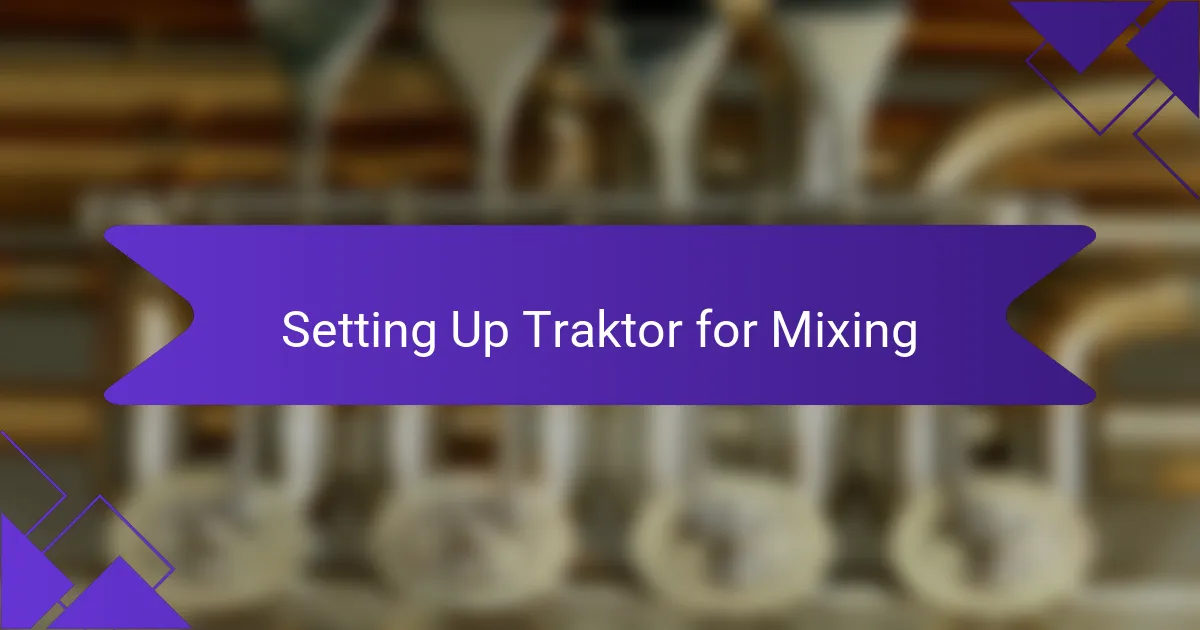
Setting Up Traktor for Mixing
Getting Traktor set up for mixing is crucial for a smooth experience. I remember when I first started mixing; the right setup made all the difference. I spent hours tweaking settings to find what suited my style best, and I realized that familiarizing myself with the software’s interface helped boost my confidence behind the decks.
Here’s my go-to checklist for setting up Traktor effectively:
- Update Traktor to the latest version; this ensures you have the newest features and bug fixes.
- Configure audio settings to match your sound card for optimal sound quality.
- Create playlists tailored to your mixing style; having them organized saves time during a live set.
- Set up hot cues and loops; these are essential for seamless transitions and creative mixing.
- Customize your MIDI mappings if using controllers; personalizing your setup can enhance your workflow.
- Practice your setup to get comfortable; the more you use it, the more intuitive it becomes.
This simple yet effective approach drastically improves my mixing sessions and allows me to express my creativity without technical hitches.
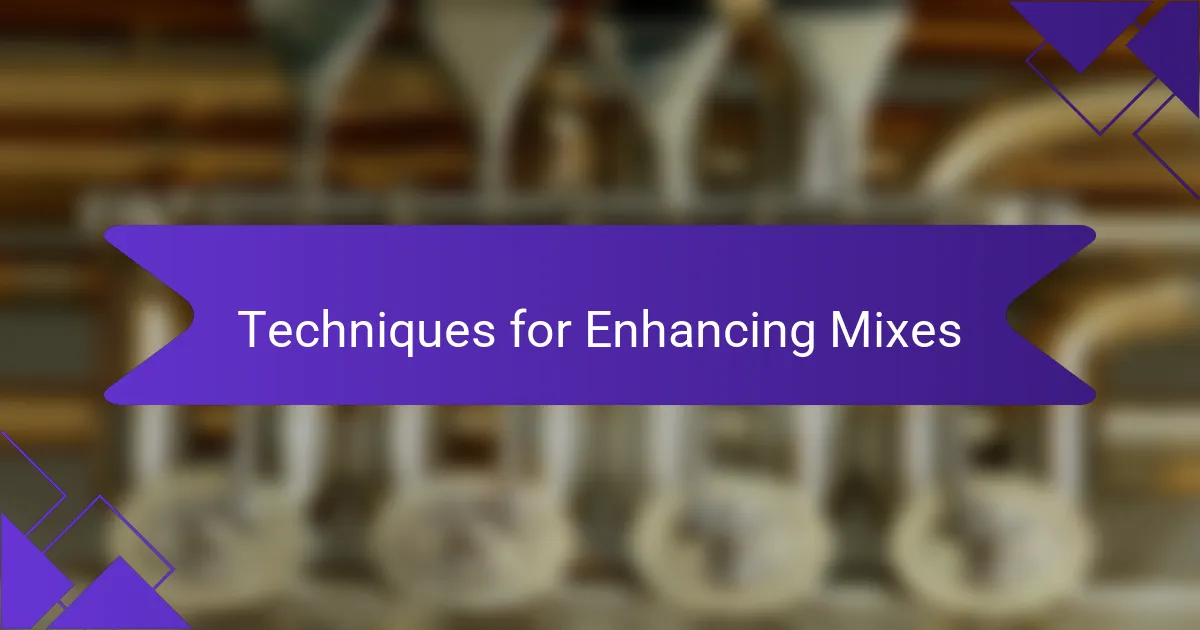
Techniques for Enhancing Mixes
When it comes to enhancing mixes, one technique I find invaluable is layering different elements. I often experiment with adding acapellas or melodic samples that complement the main track. This not only creates a richer sound but also adds excitement to the mix. Have you ever heard a vocal snippet drop perfectly over an instrumental? It creates a unique atmosphere that captivates the audience.
Another technique I cherish is utilizing effects strategically. Whether it’s reverb, delay, or slight filtering, these effects can transform a basic transition into something extraordinary. I remember the first time I applied an echo effect just before a drop; the crowd’s anticipation skyrocketed. The blend of sound and silence in that moment made it even more powerful. How do you approach effects in your mixes? I often find less is more, allowing the music itself to shine through.
Finally, adjusting the energy levels throughout a set is something that has always elevated my performances. I keep an eye on the crowd to gauge how they react. If the energy dips, I’m quick to switch to an uplifting track or introduce a heavier bass line to bring them back. It’s a delicate dance, but getting that right flow makes the experience unforgettable for everyone. Have you considered how pacing impacts your audience’s energy? For me, it’s what sets a great DJ apart from an unforgettable one.
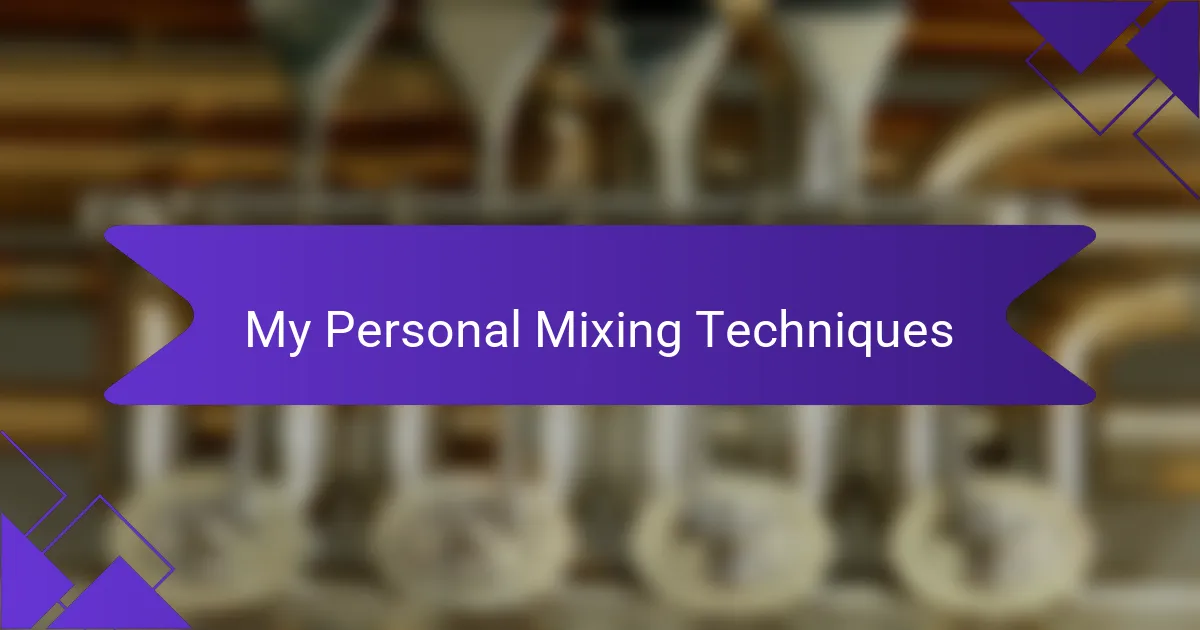
My Personal Mixing Techniques
Mixing is all about connecting with the audience, and I often start my sets by establishing a groove that resonates with the crowd. I like to begin with tracks that have a strong beat, allowing people to feel the rhythm immediately. There’s something exhilarating about watching the crowd vibe with the music. I remember a night when I kicked off with an old-school track, and the energy in the room shot up instantly—everyone was singing along, and it created this amazing collective experience. This is the magic of starting off strong.
One technique I employ is to utilize tension-building tricks before transitions. For instance, I frequently play with filters, rolling off the bass to set up a drop. In one memorable set, I created a moment of suspense right before an explosive bass drop, and the crowd went wild! Have you ever experienced that rush of anticipation? It’s a powerful way to elevate both your energy and the audience’s. Incorporating these small techniques can make a significant impact and truly define your personal mixing style.
Finally, I can’t stress enough the importance of practicing with different genres. Mixing isn’t limited to a single style; it’s about blending influences. I often challenge myself by mixing tracks from various genres and eras, which not only keeps things fresh but also ignites my creativity. A while back, I mixed an upbeat house track with a classic rock anthem, and it caught everyone off guard in the best way. Have you ever pushed your limits like that? Those moments are what keep me excited about DJing and continually evolving as an artist.

Tips for Mastering Traktor Skills
When it comes to mastering Traktor, practice is key. I often set aside dedicated time each week to experiment with different features. Whether it’s using effects or managing my playlists, I find that hands-on experience reveals all the little nuances that resources sometimes overlook.
Building custom mappings for my controllers has been one of the most gratifying experiences. It may seem tedious at first, but once you get the hang of it, the tailored control over your setup can elevate your performances significantly. Remember, every DJ has their unique style. Embrace yours and let Traktor tailor your mixing experience.
I also recommend utilizing the Remix Decks. They allow me to incorporate samples and loops seamlessly into my sets, adding that extra layer of creativity. It’s exhilarating to see how each session helps refine my skills further. Are you ready to dive into the world of Traktor? It’s a journey worth taking!
| Tips | Description |
|---|---|
| Practice Regularly | Dedicate specific time to experiment with features and tricks. |
| Customize Controller Mapping | Create personal layouts for better control and performance. |
| Use Remix Decks | Add samples and loops for enhanced creativity and excitement in your mixes. |
